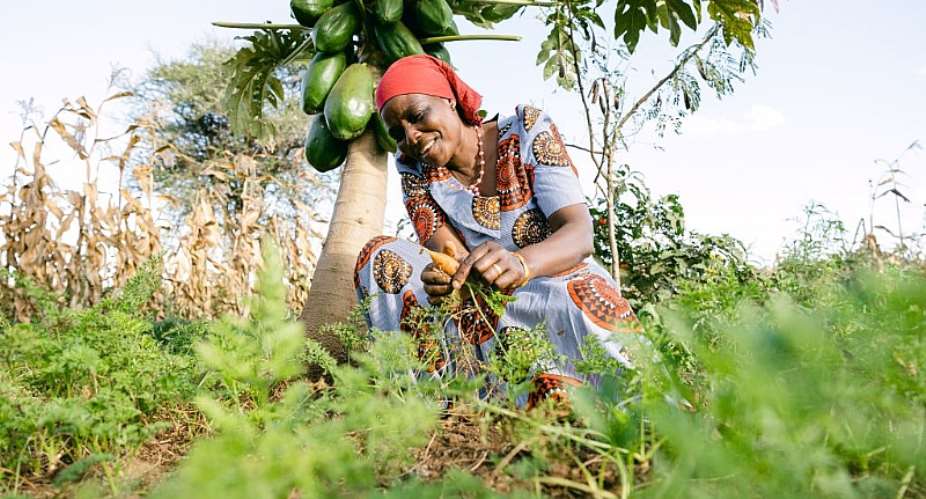Nairobi, 13 February 2024 – When Africa’s fertile terrains become drylands, farmers are thrown into poverty and biodiversity shrinks. Trees for the Future (TREES) is successfully reversing this trend, assisting hundreds of thousands of smallholder farmers in several African countries – from Senegal to Tanzania - to fight soil degradation, biodiversity loss and climate change. TREES was announced today as one of seven UN World Restoration Flagships.
“My life has changed. Birds are chirping, my children are laughing, life is everywhere,” says Trees for the Future farmer, Paul Magna, who now farms a mix of species like carrots, lettuce, and fruit trees in Kenya.
Trees for the Future has restored 41,345 hectares since 2014, an area about the size of Tanzania’s capital, Dodoma, as well as supporting over 50,000 households and capturing 347 metric tonnes of CO2per hectare through its model – the equivalent of emissions from over 100,000 litres of diesel consumed. Drylands restoration also helps increase the income and improve the health of farmers and their families. The TREES initiative is expecting to create 230,000 jobs by 2030 in Kenya, Mali, Senegal, Tanzania, and Uganda.
The World Restoration Flagship awards are part of the UN Decade on Ecosystem Restoration – led by the UN Environment Programme (UNEP) and the Food and Agriculture Organization of the UN (FAO) – which aims to prevent, halt, and reverse the degradation of ecosystems on every continent and in every ocean. The awards track notable initiatives following global commitments to restore one billion hectares – an area larger than China. The award for the African Forest Gardens was announced by UN Goodwill Ambassador for Biodiversity, actor and filmmaker, EdwardNorton.
As a World Restoration Flagship, TREES will now be eligible for technical and financial UN support. Together with envisioned new partners and funding sources, TREES is now aiming at restoring 229,000 hectares of drylands by 2030, an area almost 30 times the size of Senegal’s capital, Dakar. This is expected to create almost a quarter million jobs, and capture and store 79.5 million metric tonnes of CO2over 20 years - the equivalent of what a coal-fired plant would burn in that period.
“In 25 years, Africa could represent a quarter of the world’s population. Yet much of the continent’s land will have already degraded into drylands that cannot feed so many people. Protecting the little fertile lands that are left is simply not enough,” said
Inger Andersen, Executive Director of UNEP. “Initiatives like TREES are playing an important role in reversing decades of ecosystem degradation, especially across the Sahel, pushing back desertification, increasing climate resilience and improving the well-being of farmers and their communities.”
The initiative works closely with tens of thousands of farmers living in poverty on degraded lands following decades of unsustainable agriculture practices, deforestation, pollution, and climate change. TREES provides training in a regenerative agroforestry technique called the Forest Garden Approach. In this four-year programme, farmers receive training, seeds, and other resources, while
planting thousands of trees and dozens of food and resource crops on their property. Participating farmers typically own one hectare of land or less.
“TREES has greatly boosted my confidence in farming,” says Forest Garden farmer Dan Oliech. “My Forest Garden is my supermarket!” Mr. Oliech owns a small plot near the shores of Lake Victoria in Kenya, where he grows cassava, banana and mango.
Trees for the Future’s projects in Senegal and Mali are a part of the African Union’s initiative. “Once it’s completed, the Great Green Wall will be the largest natural structure on the planet,” says Elvis Tangem, Great Green Wall Initiative Coordinator. “It’s a massive undertaking, but the dedication and teamwork of organizations like Trees for the Future will ultimately make it a reality.”
“We are honoured to receive such a prestigious award from UNEP and FAO. Partnerships like the one we’ve developed with the incredible Flagship team are key to expanding our work to not only combat climate change, but also improve the lives of the farmers we partner with,” says Trees for the Future CEO Tim McLellan.
As a World Restoration Flagship, TREES is recognized as one of the best examples of large-scale and long-term ecosystem restoration in any country or region, embodying the 10 Restoration Principles of the UN Decade on Ecosystem Restoration. The announcement of seven new World Restoration Flagships was made ahead of the 6th UN Environment Assembly (UNEA-6), to be held from 26 February to 1 March, 2024. The Assembly convenes the world’s Environment Ministers in Nairobi, Kenya, to address the triple planetary crisis of climate change, nature and biodiversity loss, and pollution and waste.





 Ensure private schools employ professional teachers, not SHS graduates — Xandy K...
Ensure private schools employ professional teachers, not SHS graduates — Xandy K...
 Alan Kyeremanten was the brain behind Ghana Card not Bawumia — Hopeson Adorye
Alan Kyeremanten was the brain behind Ghana Card not Bawumia — Hopeson Adorye
 I'm not running for office for power prestige, I just want to solve Ghana’s prob...
I'm not running for office for power prestige, I just want to solve Ghana’s prob...
 Provide immediate assistance to our displaced residents — Oda Nkwanta residents ...
Provide immediate assistance to our displaced residents — Oda Nkwanta residents ...
 Send nurses abroad; it’s a better option than being unemployed in Ghana — NDC Pa...
Send nurses abroad; it’s a better option than being unemployed in Ghana — NDC Pa...
 Bawumia stole free tertiary education for Persons with Disabilities from NDC’s 2...
Bawumia stole free tertiary education for Persons with Disabilities from NDC’s 2...
 Ejisu by-election: Anger is bound to occur but return to your 'sweet home' — Nan...
Ejisu by-election: Anger is bound to occur but return to your 'sweet home' — Nan...
 Limited voters registration: Don't allow politicians to engage your minors for p...
Limited voters registration: Don't allow politicians to engage your minors for p...
